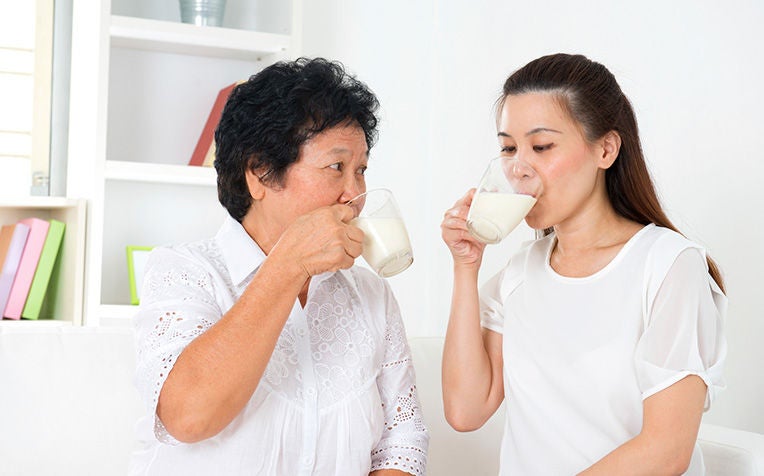
Milk is a good source for calcium which is important to maintain strong bones.
Brittle bones are more prone to fractures. These fractures may happen even with very minimal trauma. "Although any bone can be affected, the fractures typically occur in the hip, spine and wrist," say doctors from the Department of Endocrinology at Singapore General Hospital, a member of the SingHealth group.
Although women 50 years or older are most at risk for osteoporosis, younger women and men can also be affected.Worldwide, 200 million women suffer from osteoporosis and a woman’s risk of hip fracture is the same as her combined risk of developing breast, uterine and ovarian cancer. In Singapore, the number of osteoporosis-related hip fractures in women over 50 years is 8 times more than the number of breast cancer cases.
Who is at risk of developing osteoporosis?
Although women 50 years or older are most at risk for osteoporosis, younger women and men can also be affected.
Peak bone mass is attained by the age of 30. After that, bone mass gradually decreases. In pregnant and lactating women, the pace of bone loss will temporarily increase if the increased calcium demands of pregnancy or breastfeeding are not met by increased dietary intake of calcium. In women, there is also a significant decrease of bone mass in the immediate period following the onset of menopause.
Risk factors for osteoporosis
The risk factors for osteoporosis can be divided into those that can be changed and those that cannot be changed.
Risk factors of osteoporosis that cannot be changed
- Age – the risk for osteoporosis increases as one gets older
- A woman who has gone through menopause. After menopause, the body produces less oestrogen – oestrogen protects the body from bone loss
- Family history of osteoporosis or osteoporosis-related fractures
- Slender body frame (small bone structure)
- Race – a person of Caucasian or Asian ancestry is more at risk
- Low bone mass or osteopenia
- Previous fracture following a low level trauma, especially after age 50
Risk factors of osteoporosis that can be changed
- Smoking – don’t smoke as smoking causes bone loss and early menopause
- Excessive alcohol consumption – an excessive amount of alcohol not only reduces bone formation, it also affects the body’s ability to absorb calcium
- Sedentary lifestyle
Other causes of osteoporosis
- Medication: Using some medication long term can damage bone. These include corticosteroids to treat chronic conditions such as asthma, rheumatoid arthritis etc, medications that lower sex hormones, some anti-seizure medications and sometimes thyroid hormone when prescribed in high doses. Talk with your healthcare provider about the medications you take.
- Other conditions: Various conditions can interfere with calcium absorption and contribute to bone loss. These include liver or kidney disease, diabetes, hyperthyroidism (overactive thyroid), Cushing’s disease (in which the body produces excess cortisol) and conditions like anorexia nervosa.
Symptoms of osteoporosis
Osteoporosis is called the ‘silent disease’ because bone loss occurs without symptoms and is painless. The condition often is not detected until it is quite advanced. Some signs in the advanced stages may include:
- Fracture of the hip, spine and wrists
- Back pain
- Loss of height over time
Diagnosing osteoporosis
Osteoporosis can be detected through a Bone Density Test most commonly done using a DEXA scan. The test can determine if you have osteoporosis by measuring the bone mineral density or bone strength at the hip and spine.
The test is quick and painless and is similar to having an x-ray taken, but uses much less radiation.
Ref: S13
Contributed by


















 Get it on Google Play
Get it on Google Play